Salesforce is one of the world’s leading CRM solutions. Sales and marketing teams globally use the Salesforce platform as their single source of truth and a place to store their customer data.
And yet, there are countless new Salesforce alternatives launched every year.
Salesforce also comes with a huge number of data integration options. In this blog post, we examine some of the most valuable Salesforce integrations – and what they can do for your sales and marketing automation.
Who can access a Salesforce data integration?
You can access just about any Salesforce integration available, but you must have a paid plan to get started. Salesforce CRM pricing is complex and broken down into different categories, such as marketing, sales, service, small business, and others.
However, despite being complex and powerful, Salesforce requires integrations to give your sales team so they can get the most out of it.
If you want to integrate Salesforce with a specific app and exchange external data with this tool, it's best to look into that integration before committing. Some Salesforce integrations are only available on certain plans, so do your research first.
The best Salesforce integrations for sales and marketing teams in 2024
Already using this tool and wondering which Salesforce integration is worth your time? Are you looking for a new CRM and are putting all your customer data in Salesforce? These are some of the top ways you can integrate Salesforce into your workflow and save time for your sales reps.
Capsule CRM
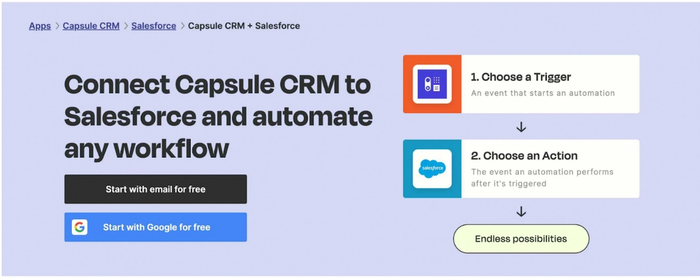
Have you heard about the Capsule-Salesforce integration? Before you transition from Salesforce to Capsule, you can use them together. The Zapier integration can help you bridge the gap before moving to the more affordable and easier-to-use Salesforce alternative.
Here are some ways the two tools can work together:
- Create Salesforce leads from new or updated Capsule CRM contacts
- Update Salesforce contacts when new or updated contacts are detected in Capsule CRM
- Create Salesforce contacts from new or updated Capsule CRM contacts
- Add contacts to Salesforce campaigns from new or updated opportunities in Capsule CRM
Through Zapier, you can set up a series of triggers and actions to make the most out of Salesforce and Capsule CRM combined.
Or instead, you can sign up for a free trial of Capsule CRM and see why it’s easy to use and how it fits into a team of any shape and size.
Google (G Suite)
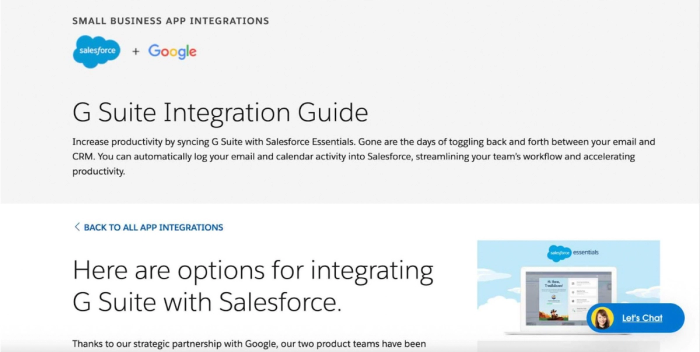
The Salesforce integration with Google's package of services is built to enhance the Salesforce user interface and provide value to end users.
On their website, Salesforce stresses that both parties have worked hard on making both tools useful for sales reps, account managers, marketers, and others.
Here are some ways you can integrate Salesforce with Gmail:
Lightning for Gmail: bring all your external data from Salesforce directly into Gmail. Account data, records, opportunities, and more, instantly become available in your Gmail account and Google Calendar. This integration platform allows sales reps to edit Salesforce records or create new ones, directly from Gmail
Google Drive and Files Connect: easily add Google Drive files and folders to Salesforce data systems. For example, if there’s a contract or some other data stored in Google Drive, simply connect to a Salesforce record or process
Data Connector: point-to-point integration between Google Sheets and Salesforce, allowing Salesforce users to send data both ways
Mulesoft integrations: Mulesoft is a separate Salesforce product and purchasing it allows you to integrate Salesforce directly into other apps. In this case, you can use Salesforce data in Google Calendar, Google BigQuery, Google Sheets, and Gmail.
If you’re not set on using Salesforce as your CRM, Capsule has an integration with Gmail too. WIth Capsule and Gmail, you can see all the details about a prospect directly in the email. Store conversations, capture customers’ information (such as social profiles), add and assign new and follow-up tasks for your sales team and more.
Slack

The extensive data integration with Slack was a natural step forward since Slack was acquired by Salesforce in 2021. If you use Slack for your team communication, you’ll also benefit from the two apps exchanging data with each other.
You can search for a Salesforce instance from Slack and share the results in Slack. You can send communications back and forth, from Salesforce Chatter to Slack channels and vice versa.
This is pretty much it if you want to grab the Slack integration from the AppExchange marketplace. For more complex integrations and workflows, you are forced to use the MuleSoft Composer. You can then create processes such as sending messages to Slack whenever a deal is won in Salesforce.
In other words, if you want your sales teams to get the most out of the Salesforce and Slack combination, you’ll have to Salesforce's proprietary external system and link the two.
By the way, you can also connect Slack with Capsule through Zapier. If you want a faster, more intuitive CRM while still being able to see CRM updates in Slack, Capsule gives you just that.
Intuit Quickbooks

Quickbooks is a popular accounting platform for small businesses, allowing them to easily track revenue and expenses, prepare for taxes, and more. It's a superb way to exchange information between accounting and sales and stay in the loop with your finances.
The issue with this Salesforce integration is that the only way to access it is through Mulesoft. You have to integrate Salesforce and Quickbooks through a third-party service.
At Capsule CRM, Quickbooks is one of our most popular and used integrations. You can use it to easily sync your Quickbooks and CRM data and view all the information from Quickbooks directly in your CRM.
Simply click on an account to view their invoices, overdue amounts and customer value in Capsule. This lets you keep track of all your sales activities in one place and helps your sales team provide a more personalized service.
Typeform
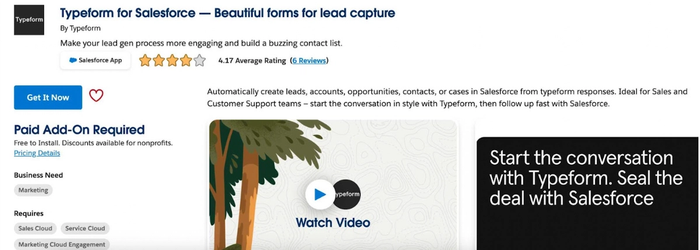
You can grab this app from the Salesforce AppExchange marketplace. Typeform is a data capture app that uses forms on your website to collect information from customers.
For example, opt-in forms for email marketing campaigns, sales demos, lead magnet sign-up forms and more.
When you connect Typeform to Salesforce, you can capture leads from your website directly to the CRM. Not only that, but you can map entries in Typeform to fields in Salesforce. For example, you can prioritize customers with a bigger company headcount and assign them special fields in Salesforce.
This can improve the customer experience and also help your sales team find high-quality leads more quickly.
To access Salesforce's integration with Typeform, you'll need a paid Typeform account.
Or if you use Capsule, there is an even easier way to connect forms with your CRM, and it’s called Transpond. With this app, you can easily build and embed forms into your website to collect customers’ data.
It boasts some great features such as landing page redirects (to confirm that the data was entered, to thank the visitor for submitting their information, etc.), confirmation emails for new subscribers or leads, as well as duplicate email detection.
MailChimp
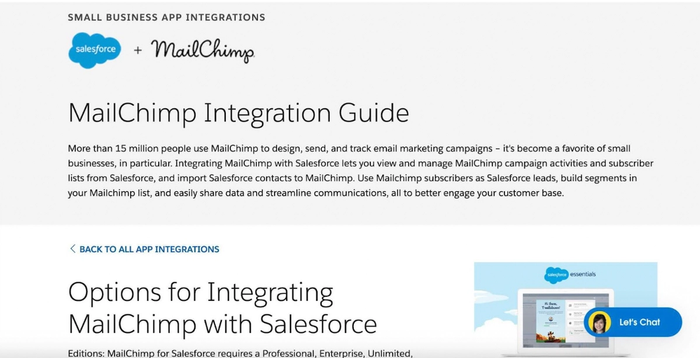
Mailchimp has over 15 million users globally. With the Mailchimp integration for Salesforce, you can get valuable insights about your email lists and contact records. If you drive revenue from email marketing, this is arguably the best Salesforce integration to consider for your sales teams.
Salesforce users can simply connect the two apps through the Salesforce AppExchange. Alternatively, you can use other tools such as Zapier or Workato to connect the two apps.
Here's what you can do with MailChimp and Salesforce:
- View and manage MailChimp campaign activities in Salesforce
- Import Salesforce contacts to MailChimp and vice versa
- Build segments in MailChimp email lists based on Salesforce records
- View campaign reports from MailChimp directly in Salesforce
- Create custom queries.
You don't need a paid MailChimp account to access this Salesforce integration.
And if you’re not set on Salesforce as your chosen CRM, Capsule also has native integration with Mailchimp. You can get a 360 view of your customers and their interactions with you, as well as segment them into smaller audiences for more personalized communication. PS. you can connect Mailchimp and Capsule in two ways: the standard, API integration, as well as webhooks.
If you’re primarily collecting new leads through your website, using the aforementioned Transpond platform may be a better choice.
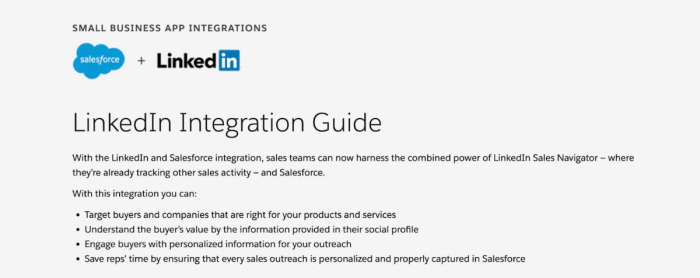
If your business already uses LinkedIn Sales Navigator for prospecting and outreach, this Salesforce integration can save considerable time and money.
There are two ways to connect these two apps and move LinkedIn data into Salesforce. First, you can get the integration directly from the Salesforce AppExchange. Second, you can connect them via the LinkedIn API (Application Programming Interface) for even faster sales and marketing automation.
Some of the things that Salesforce organizations can do with this integration include:
- Qualify and segment leads based on their LinkedIn information
- Reach out to prospects with personalized messages based on LinkedIn account data
- Log InMail messages and notes on leads directly in Salesforce CRM
- Import CRM contact information directly from Salesforce into Sales Navigator
- Use the point-to-point integration to show LinkedIn lead data in Salesforce.
For accurate sales forecasting and better customer experiences, this is arguably the best Salesforce integration that automates common sales tasks.
DocuSign

DocuSign is an online document management platform that allows businesses to sign and track agreements online. Instead of relying on paper, DocuSign helps you create legally binding documents that customers can sign online through a remote system.
You can connect DocuSign and Salesforce in three ways.
- Through the AppExchange plug-in for Salesforce
- Using the DocuSign API to make Salesforce connect directly to this app
- Through Zapier or other third-party platforms
Here is how the two apps work together:
- You can sign Salesforce agreements in DocuSign, anywhere and on any device
- Have your Salesforce documents digitized and stored in DocuSign after a thorough certification process
- Simplify approval workflows by sending DocuSign documents to Salesforce leads
- Get real-time data and updates about signed DocuSign documents in Salesforce Chatter
It's one of the best Salesforce integrations for streamlining administrative procedures and saving time for your customers.
Perhaps Docusign is not your cup of tea and you use Proposable to manage and sign your sales documents. The great news is that you can use Capsule and Proposable combined to quickly, send, track, sign and manage your sales proposals.
Gravity Forms
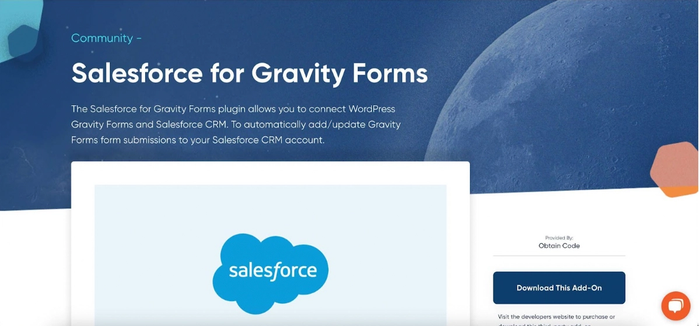
Gravity Forms is the most popular form builder for WordPress. It helps businesses to get lead contact data into Salesforce quickly and without losing valuable details.
This is a no-code integration that you can simply install as a WordPress plugin. It is not available on the AppExchange or through other connection methods.
While there are more efficient data capture methods, this is the best Salesforce integration you can get for WordPress data collection.
Dropbox Sign (formerly known as HelloSign)

This Salesforce integration is similar to Docusign. However, if you're already in the Dropbox ecosystem, it may make more sense to go for their integration too. It allows businesses to track, sign and manage documents online and connect them to Salesforce data easily.
To get this integration, you can simply download it from AppExchange and connect the two accounts together.
Like Docusign, it allows you to save contracts and agreements from Salesforce in Dropbox Sign. Your customers can sign them online and they get added to Salesforce records for the specific customer.
To access the Dropbox Sign Salesforce integration, you will need a paid plan.
Eventbrite
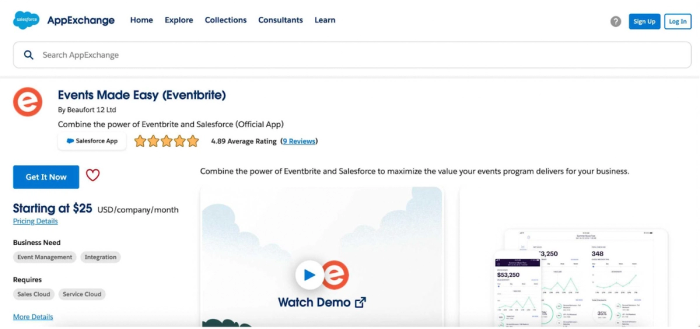
If you run many events in your business and they make up a large portion of your revenue, utilizing Eventbrite is recommended. Thanks to the Salesforce integration with this platform, you can easily get external data from Eventbrite into your CRM.
This Salesforce integration can be downloaded from the AppExchange, but it requires a paid subscription to Eventbrite.
You can use the available integration patterns to enrich Salesforce contact data with Eventbrite information. It is possible to map events, attendees, orders, canned and custom questions to Salesforce leads and contacts.
ActiveCampaign

This is arguably the best Salesforce integration for marketing automation and creating personalized experiences throughout the sales cycle. ActiveCampaign offers customer experience automation (CXA) features to make it easy to sell to your Salesforce lead lists.
You can integrate ActiveCampaign and Salesforce using the AppExchange or the bulk API offered by ActiveCampaign.
Some of the ways to integrate the two apps are:
- Using Salesforce records to enable personalized marketing automation campaigns
- Send emails and texts to segmented lead lists in Salesforce
- Connect with audiences on social media platforms and send targeted content based on Salesforce records
You will need a paid ActiveCampaign account to use this integration, though.
Calendly

The world's most renowned calendar scheduling app gets even better when connected with Salesforce CRM. Simply head to AppExchange to connect the two platforms and automate tasks related to calendar booking.
To get this Salesforce integration, you need to have a paid account on both platforms.
Some of the ways you can use Calendly and Salesforce are:
- Create and update Salesforce objects when Calendly meetings are canceled or created
- View upcoming Calendly events directly in leads' Salesforce records
- Track rescheduled and canceled events for individual event attendees
- Report in Salesforce on Calendly activity.
Dropbox

Keeping your sales team on the same page often requires managing large data batches and keeping them up to date. Cloud storage solutions like Dropbox make this job effortless. With this integration, you can upload, edit, and review files without leaving your Salesforce dashboard.
Some ways you can use this integration are:
- Synchronizing your Dropbox files with Salesforce records
- Sharing Dropbox files easily and securely with Salesforce contacts
- Collaborate on files without leaving Salesforce
You can access this integration from the AppExchange marketplace.
Should you get Salesforce for its integrations?
Salesforce has an impressive integration ecosystem and it enables sales reps to get data into Salesforce with just a few clicks.
However, Salesforce is a fairly complex CRM. For average business users, moving to Salesforce from their existing CRM based on integrations is a costly and complicated move.
Instead, consider choosing a different CRM that is simpler to use, comes with numerous integrations with external systems, and has pricing for businesses of all sizes.
Capsule CRM integrates with your most important business apps and has all the tools your sales team needs to close more deals. It also integrates with Zapier, allowing you to connect all your data with thousands of apps in the Zapier marketplace.
Give your sales team a CRM that is user-friendly and packed with valuable features. Start your free trial of Capsule CRM today.
![14 best Salesforce integrations for your sales teams [and alternatives]](https://cdn.sanity.io/images/poftgen7/production/3856cae7b5d04473f1ddc137f3250b08200adb63-4807x3205.jpg?rect=0,2,4807,3203&w=800&h=533&q=100&fit=max&auto=format)



